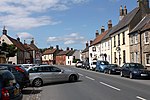Lower Woods

Lower Woods (grid reference ST743876) is a 280.1-hectare (692-acre) biological and geological Site of Special Scientific Interest near the village of Wickwar, South Gloucestershire, notified in 1966 and renotified in 1985. The site area has increased at last revision in 1974 to a 284.1-hectare (702-acre) site. The site is a nature reserve managed by the Gloucestershire Wildlife Trust. Lower Woods are the most extensive area of ancient woodlands and seminatural woodland in the former county of Avon and now in South Gloucestershire. It is one of the largest ancient woodlands in the south-west of England and covers some three square kilometres. There are three waymarked trails and over sixty miles of paths, rides and wide grassy 'trenches' (ancient roads).This large reserve is made up of twenty-three woods and coppices, the boundaries of which have remained unchanged for several centuries. The woods are linked by a network of grass trenches and ridges. The Little Avon River runs through the centre of the site. The woods are situated in the damp clay soils of the Vale of Berkeley and are made up of the distinct woodlands as well as grassland areas.The site is adjacent to Yarley Meadows which is also an SSSI.
Excerpt from the Wikipedia article Lower Woods (License: CC BY-SA 3.0, Authors, Images).Lower Woods
Shepherds Knap,
Geographical coordinates (GPS) Address Nearby Places Show on map
Geographical coordinates (GPS)
| Latitude | Longitude |
|---|---|
| N 51.587 ° | E -2.373 ° |
Address
Lower Woods Nature Reserve
Shepherds Knap
GL9 1BY
England, United Kingdom
Open on Google Maps






